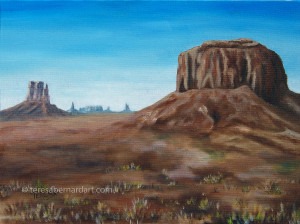List 6 Ways of Showing Depth in an Artwork Art 1

by Teresa Bernard
Depth is a bones building block of all visual art. What makes it such an important element is that it creates a potent sense of reality in a painting. It can be divers as the illusion of distance or three-dimension on a two-dimensional or flat surface. A lack of depth in a limerick means it will be less than lifelike. Therefore one tin can see but how important creating depth on a flat surface is.
Creating Depth
Primary techniques an artist tin can utilize to create depth in a painting are (1) layering and overlapping, (2) changing size and placement, (3) linear perspective, and (4) relative colour, hue, and value. Permit me explain each of these.
Layering and overlapping are placing one or more than elements in forepart of another element to create the illusion of depth in the composition. Objects that appear in front end of others seem nearer, while those backside seem farther abroad. This method is the strongest way of creating depth, and it will override all other signs when there is a seeming conflict.
Changing size and placement is another method artists use to create a sense of depth in a painting. This technique states that larger objects announced closer and smaller objects appear further away. Likewise, objects positioned at the bottom of the painting announced to be in front, and those at the top appear to be in the back.
Linear perspectiveallows artists to give the impression of depth by the belongings of parallel lines converging in the altitude at infinity. An example of this would be standing on a straight road, looking downwardly the road, and noticing the road narrows as it goes off in the distance. The point of infinity is what is called a vanishing point. These lines don't actually need to be visible, though they can be. The objects in the limerick can also imply them.
For more information about using perspective to add together dimension to your paintings, read the article titled The Rules of Perspective Drawing.
Relative color, hue, and value can also add the illusion of depth.
-
- Darker colors look closer to the viewer, and lighter colors look farther away.
- Colors that are close in value seem shut to each other, and strongly contrasting colors announced to dissever.
- Warm, bright colors (red-orange, yellow) seem to advance towards the foreground, and cool, nighttime colors (blue and bluish green and regal) seem to recede into the groundwork.
- Saturated colors seem to advance, and low saturated colors seem to recede.
Other things to consider are:
Lighting and Shading — Light adds depth by casting external shadows. Information technology as well shows depth in how information technology acts over the surface of i object. The closer to the light source, the brighter the surface is with more reflected calorie-free.
Bandage and driblet shadows are another common way to add depth. Reflections work similarly in that a reflection appears on a unlike surface. The illusion of depth can exist increased by making the shadow larger and lighter and further away from the object. Blurring the edges of shadows also increases the illusion of depth.
Focus, Texture, and Detail — Objects that are more detailed, sharper in focus, and more textured appear closer than those with less detail, blurred, or lilliputian or no texture are perceived equally far away.
*Click for more data about the bones elements of art.
Additional Reading
Using Atmospheric Perspective to Create Depth in Your Paintings
Have a question?
If you have a question about this painting, delight contact us, and nosotros'll be happy to answer whatever of your questions.
Thanks for reading this!
Feel free to share this with your friends.
Enjoy this page? Please share information technology. Thanks!
Source: http://teresabernardart.com/creating-depth-on-a-flat-surface/
Post a Comment for "List 6 Ways of Showing Depth in an Artwork Art 1"